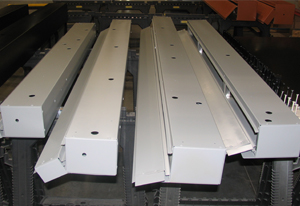 By John Baylis
By John Baylis
Flush mounting is the most common installation method for illuminated channel letter signs, but there are also two other possibilities; the signs may be mounted to either a raceway or a wireway. It is important to understand the fundamental differences between these two methods.
Raceways
A raceway is a rectangular sign mounting structure that also serves as an enclosure for both the signage’s electrical components—such as transformers—and the wiring that power the light-emitting diodes (LEDs).
Some property owners require raceway-based channel letter mounting. The primary advantage it presents over flush mounting is the need for fewer drilled holes in the building façade, which can be an important consideration for the property owner.
Raceways are often painted to blend in with the building’s façade colour. When components are to be replaced, only the top surface of the raceway needs to be removed, to allow simple and quick access.
Wireways
By way of comparison, a wireway is also a prefabricated enclosed passage for the sign’s electrical wiring, but features a slimmer, narrower aluminum enclosure and mounting structure. Channel letters are mounted to wireways just as they are to raceways.
Landlords sometimes specify wireways for channel letter mounting because they are thinner than raceways. In many instances, channel letters are only permitted—by bylaw or other regulation—to protrude from a wall up to a certain distance. So, in these scenarios, a  raceway might cause the sign to exceed the permissible protrusion distance.
raceway might cause the sign to exceed the permissible protrusion distance.
Further, a wireway may serve a ‘triple duty’ by providing a wiring enclosure, a letter mounting surface and a backing board. However, a wireway is typically not used to contain any of the electrical components. Instead, the components are usually placed inside the wall. This is because replacing any electrical components enclosed within a wireway requires the entire sign structure to be removed from the building’s façade, which can be expensive and time-consuming.
In another distinction, wireways require more mounting holes than raceways do, although still fewer than with flush-mounted channel letters.
Helpful alternatives
So, in these ways, both raceways and wireways serve as helpful alternatives to flush-mounting channel letters, particularly when the building owner is concerned about holes being drilled and when allowable protrusion space is limited. They also both make signs easier to remove and relocate as needed.
John Baylis is marketing director for Direct Sign Wholesale, which manufactures channel letters for sign shops across North America. For more information, visit www.directsignwholesale.com.





